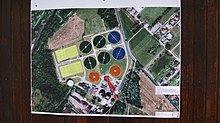Wastewater treatment plant Dornbirn-Schwarzach

The Dornbirn-Schwarzach wastewater treatment plant (ARA Dornbirn-Schwarzach) is the central wastewater treatment plant for the city of Dornbirn in the Dornbirn district and the Schwarzach municipality in the Bregenz district in Vorarlberg ( Austria ). The system covers 98% of all sewer connections in Dornbirn.
The ARA Dornbirn-Schwarzach is located in the Dornbirn district of Rohrbach , about 2.3 km as the crow flies from the city center, at one of the lowest points of the populated municipal area at 409 m above sea level. A. The plant is operated by the wastewater treatment region Dornbirn-Schwarzach Ges.mbH.
The ARA Dornbirn-Schwarzach is the third largest plant in Vorarlberg and the only one that operates a sewage sludge drying plant.
history
In September 1954, the Dornbirn city council decided to build an extensive sewer system . In 1976 the sewerage network covered around 100 km, in 1990 around 150 km and in 2015 around 350 km. The ARA Dornbirn-Schwarzach was built in 1969/1970 and at that time included mechanical cleaning and aerobic sludge stabilization with max. 4200 l / s. Until then, much of the wastewater flowed largely untreated into Lake Constance via various bodies of water .
In 1983 it was fully expanded with mechanical, biological and chemical cleaning stages for a maximum of 1864 l / s.
1991–1993 the plant was equipped with a fluidized bed fluidized bed sewage sludge drying plant. The mechanical cleaning level has been adapted to the state of the art.
In 2003/2004, as the earlier textile industries were closed or insolvent over the decades, the system was reduced in size and adapted to the state of the art (max. 1552 l / s).
Technical specifications
The plant cleans the wastewater for over 51,000 residents and the wastewater from the companies located here (around 98% of the wastewater produced). The capacity of the wastewater treatment plant is now oversized and corresponds to 150,000 population equivalents , as the textile industry used to have high chemical loads in the wastewater. The three stages of the WWTP, mechanical, biological and chemical, are structurally separate parts of the system. The chemical cleaning stage is no longer in operation because the mechanical and biological cleaning stages are sufficient.
The average retention time for the water is around five days.
Wastewater treatment plant
- Year of construction: 1969/1970 with extensions
- Annual wastewater treatment: 11 million m 3 (as of 2014)
- Energy consumption (electrical): about 14 million kWh
- Self-energy coverage for sewage sludge drying with digester gas : 60 to 70%
- Screw pumping station to raise the level
- Archimedean screws : 4 pcs.
- Output: 2 x 1400 l / s and 2 x 450 l / s.
- Primary clarifier 1 to 3
- Content: 3000 m 3
- Year of construction 1969/70
- Biological cleaning basins
- Contents: about 32,000 m 3
- Circulation: about 100 agitators
-
Secondary clarifier 1 to 4
- Diameter: 48 m
- Content: 5400 m 3
- Digestion tower 1 and 2
- Content: 5000 m 3 each
- Length of stay content: about 21 days
- Gas extraction: around 3000 m 3 per day
- gasometer
- Content: 5000 m 3
- Pressure: 0.35 mbar
- Counterweight: about 80 to (steel plate)
- Rain emergency overflow: 8300 l / s
- Chemical cleaning stage: out of order
- Pre-thickening basins 1 and 2: out of order
- Content: 530 m 3
- Post-thickening basins 1 and 2
- Content: 660 m 3
Sewage sludge drying plant
- Year of construction: 1991/1993
- Manufacturer: Andritz AG
- Capacity (in use): about 7 to / day
mud
- Annual volume: 12500 t / year
- Type of sludge: rotten
- Drainage: to 26% TS
Drying
- Sludge throughput with 26% DM: 2200 kg / h
- Water evaporation capacity: 1650 kg / h
- Energy supply: flue gas 360 ° C
- thermal energy requirement: 1360 kW
- Dry granulate production: max. 550 kg / h
- Dry residue in the end product: 75–90% TS
- Grain size: 0.5 - 5 mm
Plant operation
- Personnel requirements day shift: 1
- Personnel requirement night shift: 0 (fully automatic)
- Operating time: 24 hours a day
- Availability: 8000 h / year
Regenerative energy generation
Digester gas
In connection with wastewater treatment, gas is extracted in the digestion towers, which covers around 60 to 70% of the energy requirements for sewage sludge drying.
solar power
There is a 20 kWp photovoltaic system on the company premises.
Cultural and media
The wastewater treatment plant in Dornbirn was the location for the ORF country thriller “ Alles Fleisch ist Gras ”.
See also
literature
- Wastewater treatment region Dornbirn-Schwarzach GmbH: " Research project sewage sludge Vererdung ", Dornbirn, publisher: Abwasserreinigung Region Dornbirn-Schwarzach Gesellschaft mbH
- Wilfried Schönbäck: " International Comparison of Urban Water Management ", " 1st Country Study Austria ", Vienna 2003, publisher: Federal Chamber for Workers u. White-collar workers, ISBN 3-7062-0068-6 .
Web links
Individual evidence
- ↑ Commercial register number: FN 66100 g. Share capital EURO 500,000. The municipality of Dornbirn has a 97.5% stake in the company, the municipality of Schwarzach 2.5%.
- ↑ "Everything meat is grass": ORF "Landkrimi" with Tobias Moretti and Wolfgang Böck goes Vorarlberg ( Memento from December 17, 2015 in the Internet Archive ) and Vorarlberg.ORF.at .



